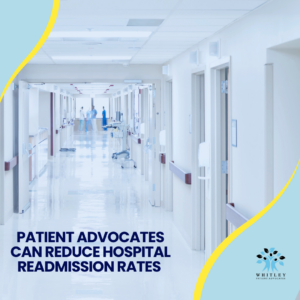Patient advocates can play an important role in reducing hospital readmissions.

Patient advocates can be effective in reducing hospital readmission rates, reducing costs with readmissions, and improving patient outcomes. We work with clients that have common health goals, stay at home as long as possible, maintain their independence as they age, and stay out of the hospital whenever possible. Basically, the work we do supports national healthcare strategies to reduce readmissions to hospitals.
What is hospital readmission?
Hospital readmission refers to the situation when a patient who had been discharged from a hospital and returned to their home due to completing the initial treatment or stabilization, ends up being admitted to a hospital again for further medical care or treatment.
Why is this a concern for hospitals?
Hospital readmissions are typically tracked and monitored by healthcare providers and policymakers as they can be an important quality of patient care indicator.
High readmission rates may suggest potential issues with:
- The quality of care provided during the initial hospitalization.
- The effectiveness of the transition of the care process.
- The patient’s overall health and compliance with post-discharge instructions.
What is a hospital readmission rate?
Hospital readmission rate refers to the percentage of patients who return to the hospital for additional care within a specified period (30 or 90 days) after being discharged from an earlier hospital stay.
The calculation involves dividing the number of patients readmitted within that period by the total number of discharged patients during the same period, and then multiplying by 100 to obtain a percentage.
The readmission rate is an important measure used to assess the quality and effectiveness of healthcare services provided by hospitals.
High readmission rates can indicate several issues:
- Inadequate discharge planning.
- Poor care coordination.
- Poor patient education.
- Incomplete recovery or follow-up care.
- Medication errors.
- Deficiencies in collaboration with outpatient healthcare providers.
It’s important to note that readmission rates can vary depending on the specific condition being treated and the characteristics of the patient population. Some patients may have a higher likelihood of readmission due to the nature of their illness or underlying health conditions.
Healthcare organizations should implement strategies and interventions to minimize avoidable readmissions with the goal to improves patient outcomes and controlling healthcare costs.
Why are Hospitals concerned about readmission rates?
1. Overall patient well-being: Readmissions can indicate that a patient’s condition has worsened or that their initial treatment was not effective. High readmission rates can be an indication of substandard care and/or the need for better management of chronic diseases.
2. Decreases patient satisfaction: Hospital readmissions can be distressing for patients and their families. Patients prefer to recover at home and avoid unnecessary hospital stays.
3. Limits overall healthcare resources: Increased healthcare utilization and strain on hospital resources are seen in overcrowding, increased demand for beds, and longer wait times for other patients. Reducing readmissions can help in managing the overall patient flow and improving access to care.
4. Negative Financial implications: Hospitals are financially penalized (through Medicare) for excessive readmissions, especially for certain conditions like heart failure, pneumonia, and chronic obstructive pulmonary disease (COPD). These penalties are there as a way to encourage hospitals to improve care quality and reduce costs.
Patient Advocates can help in reducing hospital readmissions
We believe that patient advocates can be effective in reducing hospital readmission rates, can help hospitals reduce costs associated with readmissions, and improve patient outcomes.
- Patient advocates act as a liaison between patients and healthcare providers, helping patients understand their conditions, treatment plans, and medications.
- In turn, patient advocates can help patients avoid common mistakes that lead to readmission, such as not taking medication as prescribed, missing follow-up appointments, or failing to adhere to post-discharge care instructions.
- Patient advocates can also help identify and address any issues or concerns that patients may have during their hospital stay, such as communication barriers, cultural differences, or misunderstandings about their care.
- Patient advocates are proactive. They help ensure that patients receive high-quality, patient-centered care that is tailored to their unique needs and preferences.
- Patient advocates can support and teach patients, families, and community support systems how to advocate for loved ones.
- Having individuals take the initiative in patient advocacy builds strong relationships in communities to support better health and reduce the burden on any healthcare system.
Overall, patient advocates can be an essential part of a comprehensive approach to reducing hospital readmissions and improving patient outcomes.
